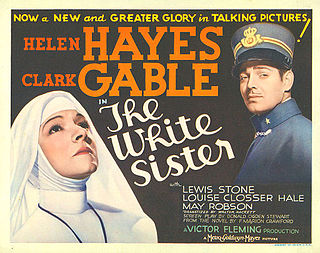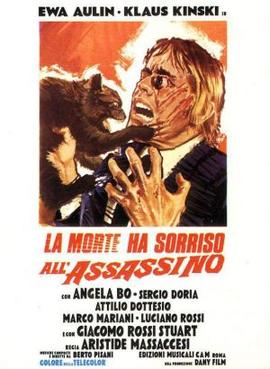Related Research Articles

The StoryTeller is a live-action/puppet television series that originally aired in 1987 and which was created and produced by Jim Henson.

Owen Moore was an Irish-born American actor, appearing in more than 279 movies spanning from 1908 to 1937.
"Not Pictured" is the second season finale of the American mystery television series Veronica Mars, serving as the twenty-second episode of the season and the forty-fourth episode overall. Co-written by series creator Rob Thomas and John Enbom and directed by John Kretchmer, the episode premiered on UPN on May 9, 2006. In this episode, Veronica learns the identity of the person responsible for the Neptune High bus crash. Meanwhile, Veronica and her classmates graduate from high school, and Neptune reacts to Aaron Echolls being acquitted.

The White Sister is a 1933 American pre-Code romantic drama film directed by Victor Fleming and starring Helen Hayes and Clark Gable. It was based on the 1909 play of the same name by Francis Marion Crawford and Walter C. Hackett. It was a remake of the silent film The White Sister (1923).

Casanova 70 is a 1965 Italian comedy film produced by Carlo Ponti, directed by Mario Monicelli and starring Marcello Mastroianni, Virna Lisi, Enrico Maria Salerno and Michèle Mercier.

Sally, Irene, and Mary is a 1925 American silent comedy drama film starring Constance Bennett, Sally O'Neil, and Joan Crawford. It is based on the 1922 play of the same name by Eddie Dowling and Cyrus Woods and takes a behind-the-scenes look at the romantic lives of three chorus girls and the way their preferences in men affect their lives. The play was adapted again in 1938, again titled Sally, Irene, and Mary and directed by William A. Seiter. That version stars Alice Faye, Joan Davis, and Marjorie Weaver in the title roles, and co-starred Tony Martin, Fred Allen, and Jimmy Durante.

The Bride Wore Red is a 1937 American romantic comedy drama film directed by Dorothy Arzner, and starring Joan Crawford, Franchot Tone, Robert Young and Billie Burke. It was based on the unproduced play The Bride from Trieste by Ferenc Molnár. In this "rags to riches" tale, Crawford plays a cabaret singer who poses as an aristocrat. This film is the last of the seven films that Crawford and co-star Franchot Tone, then her husband, made together.

Mary Pickford (1892–1979) was a Canadian-American motion picture actress, producer, and writer. During the silent film era she became one of the first great celebrities of the cinema and a popular icon known to the public as "America's Sweetheart".

The Road to Mandalay is a 1926 American silent drama film directed by Tod Browning and starring Lon Chaney, Owen Moore, and Lois Moran. It was written by Elliott Clawson, based on a story idea by Tod Browning and Herman Mankiewicz. The script's original shooting title was Singapore. The film took 28 days to complete at a cost of $209,000. The worldwide box office gross was $724,000. Some stills exist showing Chaney's makeup as Singapore Joe.

Where the Forest Ends is a 1915 American silent drama film directed by Joe De Grasse and featuring Lon Chaney and Pauline Bush. De Grasse also acted in this film as well, playing "Silent Jordan". The film was written by Ida May Park, based on a story by Olga Printzlau. The film is today considered to be lost. A still from the film can be seen online.

The Place Beyond the Winds is a 1916 American silent drama film directed by Joe De Grasse, and starring Lon Chaney, Gretchen Lederer and Dorothy Phillips. It was written by Ida May Park, based on the novel by Harriet T. Comstock. The director De Grasse also played a role in the film. The film's original working title was Mansion of Despair. A still exists showing Chaney in the role of Jerry Jo, the homeless man.

Her Country's Call is a 1917 American silent drama film directed by Lloyd Ingraham and starring Mary Miles Minter, along with George Periolat and Allan Forrest. The film is the final instalment in a series a films written by Abraham Lincoln impersonator Benjamin Chapin, who also appeared in the film as Lincoln. It was one of many films of the time that catered to the vogue for patriotic pictures after America joined World War I, with ample shots of soldiers and the American flag. As with many of Minter's features, it is thought to be a lost film.

Death Smiles on a Murderer is a 1973 Italian horror film directed by Joe D'Amato and starring Ewa Aulin, Klaus Kinski and Luciano Rossi.
Married to a Stranger is a 1997 American-Canadian made-for-television romantic drama film starring Jaclyn Smith, Robert Clohessy and Kim Coates. It premiered on The Family Channel on September 28, 1997. It was directed by Sidney J. Furie.

A Daughter of the Poor is a 1917 American silent comedy-drama film produced by Fine Arts Film Company and released by Triangle Film Corporation. The film was directed by Edward Dillon and starred young Bessie Love.

Walking on Sunshine is a 2014 British romantic jukebox musical comedy-drama film directed by Max Giwa and Dania Pasquini. The film features covers of songs from the 1980s and was released on 27 June 2014. It is also a debut role for singer-songwriter Leona Lewis.

The Girls He Left Behind Him and The Iron Clad Lover are two 1910 American silent short comedies produced by the Thanhouser Company. Both films were originally released together on a single reel and are two distinct and separate subjects. The Girls He Left Behind Him focuses on a young man, Jack Redfern, who receives a letter from an old sweetheart of his. This prompts him to reminiscence about all the girls he has had affections for on the eve of his wedding. All the old sweethearts of his life then appear at his wedding to wish him well. The Iron Clad Lover concerns two suitors who are vying for the affections of Bessie. Tom, who plays a game of chess with her father, ends up quarreling with him and he is thrown out of the house. The next day, Tom attempts to bring flowers and candy for Bessie's birthday, but is dismissed by the angry father. Tom decides to dress up in a suit of armor and ends up breaking a vase when trying to announce himself. The suit of armor is thrown out and Bessie and the other suitor chase down the junk dealer to free Tom from the suit of armor. Both films were released on December 9, 1910, and were met with positive reviews by The Moving Picture World and the New York Dramatic Mirror. Both films are presumed lost.

The Girl Who Ran Wild is a 1922 American comedy-drama film directed by Rupert Julian. It is a black and white silent film released by Universal which is based on the 1863 novella M’liss: An Idyll of Red Mountain by Bret Harte. It is a remake of the 1918 film M’Liss. The film was written by George C. Hull and features cast such as Gladys Walton, Marc Robbins, and Vernon Steele. It is a western melodrama which was released on October 9, 1922. It was filmed in Seven Oaks, California.

The Dancers is a 1925 American silent drama film directed by Emmett J. Flynn and starring George O'Brien, Alma Rubens, and Madge Bellamy. It is an adaptation of the 1923 play The Dancers by Viola Tree and Gerald du Maurier. It was remade by Fox Film five years later as a sound film The Dancers.
Lure of the Night Club is a 1927 American silent romantic-drama directed by Tom Buckingham and starring Viola Dana, Robert Ellis and Jack Dougherty. In the film, a showgirl takes a job dancing so she can save her fiancé's damaged farm after a violent storm.
References
- ↑ "The Lure of the Gown". Silent Era. Retrieved February 12, 2015.
- ↑ "Stories of the Films". Moving Picture World . New York: The World Photographic Publishing Co. March 13, 1909. Retrieved February 21, 2016.